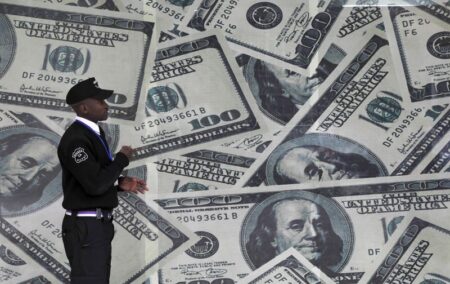By Kevin Buckland and Joice Alves
TOKYO/LONDON (Reuters) -The dollar fell on Wednesday, further retreating from a nearly three-month high against the euro hit a day earlier, with a decline in U.S. bond yields adding to the pressure.
Analysts pointed to technical factors for the dollar’s pullback, following a two-day rally of as much as 1.4% against the euro after unexpectedly strong U.S. jobs data, as well as more hawkish rhetoric from Federal Reserve Chair Jerome Powell, scuppered bets for an early interest rate cut.
U.S. Treasury yields also turned down from highs on solid demand at a sale of new three-year notes, removing some support for the dollar.
The dollar was down 0.1% to $1.0762 per euro, after retreating 0.1% on Tuesday, when it had earlier touched its strongest level since Nov. 14 at $1.0722.
The – which measures the currency against six major peers, including the euro – fell 0.04% to 104.10, following Tuesday’s 0.29% slide. It had reached the highest since Nov. 14 at 104.60 on Monday.
“Major currencies continue to prove their resilience against renewed strength of the U.S. dollar, and this resilience is preventing a further rally by the U.S. Dollar Index above 104.50,” UniCredit told clients.
“Once again, the effect of dynamics of long-term yields on the dollar remains essential, with the U.S. Treasury 10 year-yield now off from peaks of above 4.15%, which has not helped further appreciation of the greenback either.”
A sharper than expected fall in industrial production in the euro zone’s largest economy had no impact on the euro as “Germany’s industrial malaise is now a well-known story,” said Chris Turner, Global Head of Markets at ING.
The dollar edged 0.08% higher against the yen to 148.07, after sliding 0.49% on Tuesday. The currency pair tends to be extremely sensitive to moves in Treasury yields.
Analysts and traders highlight next Tuesday’s U.S. inflation data as a key test for Fed rate bets.
Traders are currently pricing in a 21.5% chance of a rate cut in March, the CME Group’s (NASDAQ:) FedWatch Tool shows, compared with a 68.1% chance at the start of the year.
“Financial markets are in the process of recalibrating their expectations for Federal Reserve policy,” said James Kniveton, senior corporate forex dealer at Convera.
“If positive economic data, particularly on inflation, persists in the U.S., the tide could turn towards earlier rate cuts, potentially weakening the greenback further.”
Read the full article here












